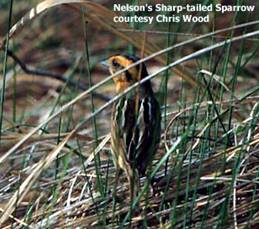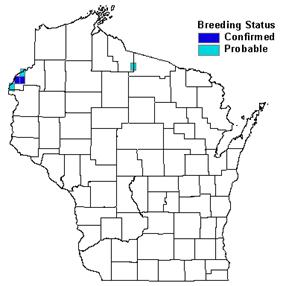

Status/Protection
- Global Rank: G5 Key to global and state ranks
- State Rank: S1B
- WBCI Priority: SGCN, PIF, State Special Concern
Population Information
The Federal BBS information can be obtained at http://www.mbr-pwrc.usgs.gov/bbs/bbs.html by clicking on Trend Estimates and selecting the species in question. All estimates are for time period (1966-2005).
- Federal Breeding Bird Survey: not well monitored by BBS
- Federal Breeding Bird Survey (WI): N/A
- Federal Breeding Bird Survey (BCR 23): N/A
- Federal Breeding Bird Survey (BCR 12): N/A
- WSO Checklist Project: NA
Life History
- Breeding Range: Prairie Provinces of Canada south to South Dakota, Minnesota, and Wisconsin; also along Hudson Bay and coast from Nova Scotia to Maine (Greenlaw and Rising 1994).
- Breeding Habitat: Northern Sedge Meadow.
- Nest: Open cup on or slightly above ground. Composed of coarse grasses, sedges and lined with fine grasses (Ehrlich et al. 1988).
- Nesting Dates: Late May through July (Greenlaw and Rising 1994).
- Foraging: Ground gleaning (Ehrlich et al. 1988).
- Migrant Status: Short-distance migrant (Ehrlich et al. 1988).
- Habitat use during Migration: Grassy marshes, sedge meadows, grassy fields and agricultural fields (Greenlaw and Rising 1994).
- Arrival Dates: Late Aril to late May (Robbins 1991).
- Departure Dates: Mid September to mid October (Robbins 1991).
- Winter Range: southeastern U.S. coast Virginia to Texas (Greenlaw and Rising 1994).
- Winter Habitat: grassy coastal marshes (Greenlaw and Rising 1994).
Habitat Selection
Nelson’s Sharp-tailed Sparrow is a specialist of large northern sedge meadows (>100 acres) and sedge marshes in extreme northern and northwestern Wisconsin. They seem to select sites with an abundance of residual vegetation (Sample and Mossman 1997). Nests are built within grass just above the ground (Greenlaw and Rising 1994). Nelson’s Sharp-tailed Sparrows are promiscuous breeders with males forming loose colonies, not assisting with brood rearing (Greenlaw and Rising 1994) and are interspecifically territorial with LeConte’s Sparrows (DeChant et al 2003).
During migration Nelson’s Sharp-tailed Sparrows are found in and around the edges of marshes, ag fields, grassy fields, etc. In Wisconsin they are regularly found in fall migration at migrant traps in Milwaukee and Nine Springs wetlands in Madison.
This species winters in coastal marshes and grasslands along the Gulf Coast from Corpus Christi, TX east to Florida.
Habitat Availability
Northern sedge meadows and sedge marshes are found throughout northern and central Wisconsin. However; due to its secretive nature, Nelson’s Sharp-tailed Sparrows have been documented as probable breeders in only a few sites. Nelson’s Sharp-tailed Sparrows are reliably found in the Crex Meadows/Fish Lake Complex and occasionally in the Powell Marsh Wildlife Area (Sample and Mossman 1997). More work is needed to determine whether other large northern sedge meadow complexes are used by this species.
Population Concerns
Nelson’s Sharp-tailed Sparrows are, and appear to always have been, rare spring migrants and rare to absent fall migrants. This species has only recently been found as a probable breeder in Wisconsin (first breeding record 1969). Wisconsin is not even included in most breeding range maps. Protection of these large northern sedge meadow sites will probably continue to benefit this species and other sedge meadow specialists. However, Wisconsin’s population is probably heavily dependent on regional source populations from Minnesota and North Dakota.
Recommended Management
Conservation of northern sedge marshes and sedge meadows is essential, especially on the larger scale that Nelson’s Sharp-tailed Sparrow requires (Greenlaw and Rising 1994). Management practices that maintain the wet grasslands Nelson’s Sharp-tailed Sparrows require should be divided into blocks so there is always breeding habitat available. A burn rotation of every 3-5 years is the best recommendation to allow the structure to return and retard woody vegetation (DeChant et al. 2003).
Anecdotal evidence from birders in southern Wisconsin suggests that this species is attracted to marshes that have been drawn-down, producing dense stands of Polygonum and Bidens. Managers that are performing these drawdowns for shorebirds and vegetation management should also be aware of this species use of the habitat.
Research Needs
The U.S. breeding bird survey gives poor sample data of Nelson’s Sharp-tailed Sparrows. There is little to no information on the interior population that Wisconsin’s Nelson’s Sharp-tailed Sparrows are a part of. Nesting productivity and density studies aimed at Nelson’s Sharp-tailed Sparrows are few and far between. Population effects from open water marsh management practices are unknown and would be useful for management purposes (Greenlaw and Rising 1994).
Information Sources
- David Sample, Grassland Community Ecologist, Wisconsin DNR Research Center, 1350 Femrite Dr., Monona, WI 53716.
- North American Breeding Bird Survey: http://www.npwrc.usgs.gov
- Wisconsin Breeding Bird Atlas: http://www.uwgb.edu/birds/wbba/
References
- Dechant, J. A., M. L. Sondreal, D. H. Johnson, L. D. Igl, C. M. Goldade, A. L. Zimmerman, and B. R. Euliss. 2003. Effects of management practices on grassland birds: Le Conte's Sparrow. Northern Prairie Wildlife Research Center, Jamestown, ND. Northern Prairie Wildlife Research Center Online. http://www.npwrc.usgs.gov/resource/literatr/grasbird/lcsp/lcsp.htm (Version 12AUG2004).
- Greenlaw, J. S. and J. D. Rising.1994. Sharp-tailed Sparrow (Ammodramus caudacutus). In the Birds of North America, No. 112 (A. Poole and F. Gill eds.). Philadelphia: The Academy of Natural Sciences; Washington, D.C.: The American Ornithologists’ Union.
- Robbins, S. D., Jr. 1991. Wisconsin Birdlife: Population and distribution past and present. Madison, WI: Univ. Wisconsin Press.
- Sample, D. and M. Mossman. 1997. Managing Habitat for Grassland Birds: A Guide for Wisconsin. Wisconsin Department of Natural Resources: Madison, WI.
Contact Info
- Compiler: Jenny Herrmann, mherrmann4@wi.rr.com
- Editor: Andy Paulios, Andy.Paulios@dnr.state.wi.us
